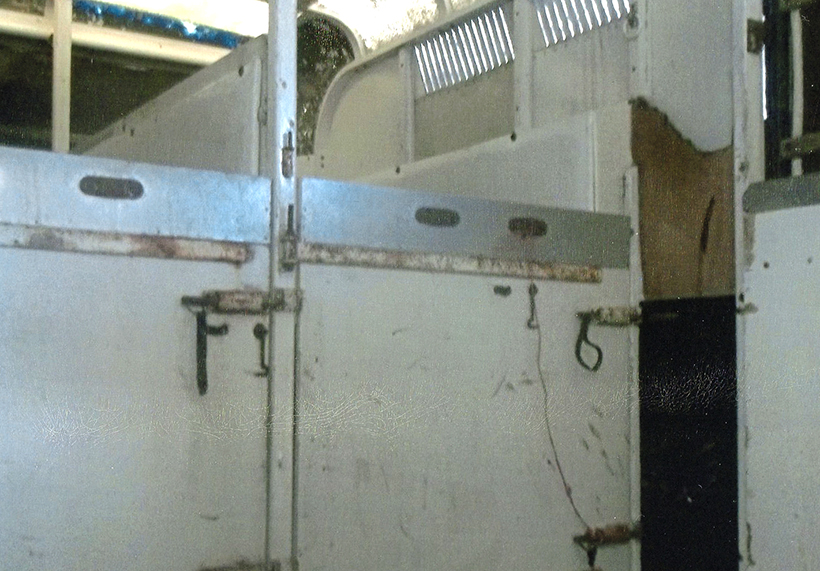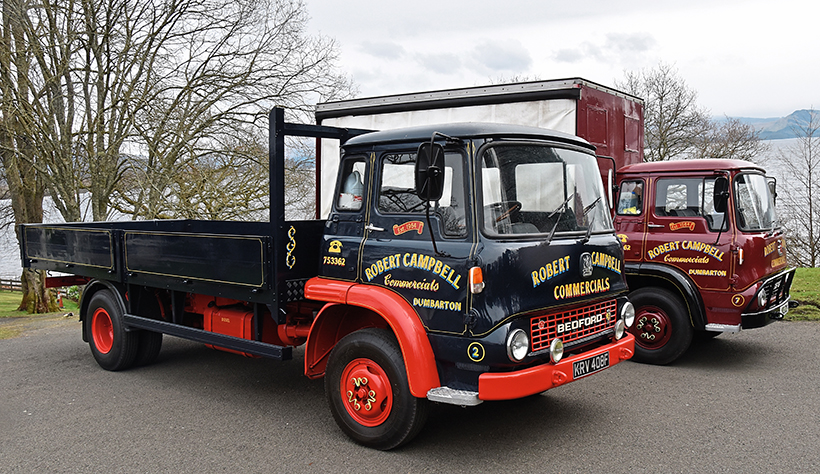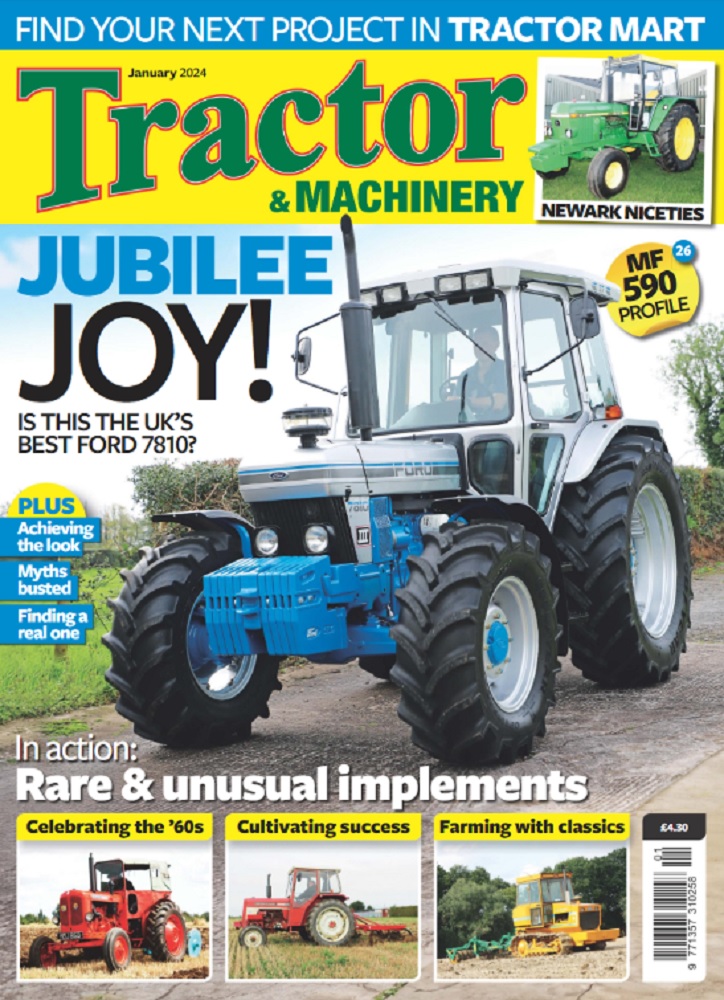A beautifully restored, 1973 Bedford TK horsebox
Posted by Chris Graham on 29th September 2023
Bob Weir meets Robert Campbell and his beautifully restored, 1973 Bedford TK horsebox that possibly has Royal connections.

Robert Campbell and his beautifully restored, 1973 Bedford TK horsebox.
The area around Glasgow has a tradition for making commercial vehicles, and the Vale of Leven is just a stone’s throw away from Albion Motors’ old factory at Scotstoun, on the banks of the River Clyde. The site of the BMC factory at Bathgate is also just down the road.
Robert Campell, whose family have lived in the area for years, owns Robert Campbell Commercials. “My father started the business back in 1964 using the severance pay he got from an engineering job,” Robert explained. “By coincidence, he was working on the same site that our company uses today, although the business has been located at several different depots over the years. He began by dismantling old cars, before moving on to trucks and other commercials. This still forms part of our business, although the vehicles have obviously changed over the years.”

As the horsebox arrived. Although the bodywork had certainly seen better days, the engine started up without any problems.
The Clyde Valley is famous for its engineering skills, and it was no surprise when Robert joined the business as soon as he left school, aged 16. “It was always the plan that I would join the firm as soon as possible. The business was still growing, so the move made sense. I was used to being around old commercial vehicles from the age of 10, so I already knew most of them back to front. I was familiar with all the marques, along with their strengths and weaknesses. I passed my HGV licence as soon as I reached 21, and have driven lots of different makes over the years. Although synchromesh gearboxes had become commonplace, I also had to learn how to handle the ‘crash’-type ‘boxes used on the older vehicles.”

The interior also had to be completely refurbished.
Despite his passion for old lorries, Robert has only started putting together his own collection in the past few years. His stable includes an Austin Loadstar, a pair of Bedford TKs, a 1954 Albion Claymore and a converted Albion WD CX24S tank transporter nicknamed The Beastie. Most of the vehicles were restored or refurbished in-house and, with the odd exception, now wear the Campbell livery.
“I acquired my first lorry back in 2012,” said Robert. “It was The Beastie, and other vehicles have followed at regular intervals over the years. I spend most of my weekends during the summer going to various rallies on both sides of the border, and I usually get to talk to a lot of other enthusiasts. There are also some good vehicle auctions held up in Scotland, including those run by the Morris Leslie Group, based at Errol airfield, in Tayside.”

Plenty of general grot to attend to.
The collection
The Beastie is one of Robert’s favourite lorries, and still brings back some fond memories. “I’d read about the tank transporter in various publications over the years, but had never been able to figure out where the lorry was actually located,” he explained. “Much to my surprise, it eventually turned out to be living just up the road, on the outskirts of Stirling. When I first clapped eyes on the vehicle, it was totally covered by tarpaulins. Its refurbishment involved a fair bit of work, but I was very pleased to start my collection with such a rare lorry.

More work for Robert’s Polish employee, Stan.
“The other Albion, a FT27AL Claymore, was originally fitted-out as a horsebox, and worked at a local abattoir. By the time I got hold of it, the lorry was mechanically sound, but the bodywork needed tidying up. We took care of all the work in-house. Fortunately, I have plenty of space in my yard although, as I keep adding to the collection, things are starting to get a bit tight nowadays. The Albion is a popular commercial at shows, and I usually put another old vehicle on the flatbed to add a bit more interest.
“I got the Austin Loadstar from an old friend in North Lanarkshire. My father owned an ex-military version when he started the business, and I wanted to replicate what my father’s Loadstar would have looked like back in the 1960s. My friend’s Austin had a similar background, and he kindly let me have the lorry for nothing. Although the lorry was in a bit of a state, every detail had to be spot on, right down to the company paintwork.”

The body was in very poor condition and needed extensive restoration.
Robert is also fond of the Bedford TK, partly because the design was ahead of its time. “I now own three TKs. There’s over a decade between the oldest and newest. KRV 408F was also originally kitted-out as a horsebox, and WDS 102V served several years with the RAF. I’ve been told it was eventually converted into a tipper. Like a lot of TKs, they were used for a variety of tasks and, over time, this usually took its toll. When I acquired the 1979 lorry it was only fit for scrap, but I took a deep breath and decided to proceed with the restoration. We had a few hairy moments but got there in the end.”

GC Smith Ltd specialised in horseboxes, and was in business for more than 50 years.
Despite the many responsibilities involved in running the family business, Robert always keeps one eye open for his next lorry. “I try all the usual sources,” he said. “The specialist magazines like Classic & Vintage Commercials are useful, and there’s always the internet. This has become so relevant in recent years it makes you wonder how we ever managed in the past.
“You can also chat to other owners when you go to rallies, because a few of them may be tempted to part with their vehicles. I also regularly visit classic auctions. It’s nice to see a lorry in the flesh, before you decide to put in a bid. This doesn’t guarantee you won’t get carried away in the heat of the moment, and end up paying too much for a vehicle, but it does give you an opportunity to spot the obvious duds.”

Robert’s example is fitted with Bedford’s petrol six-cylinder engine. Although the diesel models were generally used by companies, so many horsebox owners prefer the refinement of petrol, and with lower typical mileages, lack of economy is less important.
“Stan Fix, go away”
However, the main subject of this feature is Bedford horsebox, JJU 581L. “The owner came from Beattock near the M74 motorway. It had already been offered to one of my friends, who had turned it down because it needed a lot of work. Most of the lorries I buy need refurbishing, and I’m usually happy to take up the challenge. A lot of our family and employees are experienced mechanics. We also have a Polish fabricator-cum-welder, who has been with me for several years. Stan speaks very little English and has a favourite one-liner when he’s quizzed too closely, which runs along the lines of: Stan fix, go away!”.

The box was built to carry two horses in comparative luxury.
According to Robert’s sources, JJU 581L may even have some royal connections. “It’s just a rumour, but I was informed by the previous owner that the Bedford had originally been bought by a member of the Royal family. It could all be idle gossip, of course, but there’s no reason to suppose people would make it up. The vehicle is certainly not the standard specification, and was modified after it left the factory.
“When I rang Bedford specialists Midland Auto Spares to buy some parts, I was told that they only record of the lorry available suggested that it had been sent to Bedford Special Vehicles. After some further digging around, it was also discovered that the vehicle had been a one-off build for a ‘special customer’. Any other details had been omitted from the file. The vehicle was fitted with a larger-than-normal tank, a high-ratio differential and bigger brakes.”

Like most horseboxes, this one appears to have always been exempt from tachograph regulations.
Robert was, however, disappointed when he first clapped eyes on the lorry. “I had bought the Bedford ‘unseen’, which always carries a certain amount of risk,” he explained. “We’ve always managed to take care of any problems in the past, but this time I thought I’d overstepped the mark. The wooden part of the bodywork was completely rotten. The owner told me that he’d tried to have it restored on several occasions, but nothing had quite worked out and, having retired, he’d then lost interest. The condition was, however, reflected in the price, and I was almost on the verge of cutting my losses.”
Having returned the Bedford to the company yard on the back of one of his flats, Robert added some petrol and connected a battery. “Much to my surprise, the engine started and ran beautifully, which was one of the few plus points,” he recalls. “The Bedford is a model TK 570 and was first registered in 1973. It’s also equipped with a type 214 six-cylinder petrol engine.”

The Bedford TK was an ideal design for converting into a horsebox, and a favourite with specialist coachbuilders.
Robert has developed a routine over the years to complete a restoration as soon as practicable. It works, too, as despite the amount of work needed, the Bedford’s restoration was completed in just 12 weeks. Yes, 12 weeks, not 12 months or 12 years!
“Running a business is both hard work and time-consuming,” he explained. “We want to carry out the restorations to the right standard, but within as tight a schedule as possible. I’ve developed a list of reliable suppliers over the years, and always buy new where possible.
“We decided to refurbish the mechanics, before starting on the bodywork. This included replacing all the brakes and wheel cylinders. We also fitted a set of new tyres, petrol pipes and exhaust. Although some of the metalwork was in reasonable condition, all the wood had to be stripped off. There are no shortcuts to this part of a restoration, and the job took many man-hours to complete. The cab floor, cab steps and mudguards also had to be replaced. The front of the cab had seen better days, and we also had to find a new front bumper. The metalwork also had to be sanded down and repaired where necessary. Once everything was ship-shape, we then applied the primer and paint.”

Robert’s other two TKs. The model was a market-leader in the 1960s but, by the time WDS 102V was registered in 1979, the TK was nearly 20 years old and becoming outdated, though plenty of people still bought them.
Since completion, the Bedford has been out and about at several shows around central Scotland, though current fuel costs have restricted outings a little over the past year or so. It’s certainly one to look out for, though, and needless to say, if anyone reading this recognises the box and/or its JJU 581L registration, do please get in touch, irrespective of whether what you know confirms or disproves the royal connection.
This feature comes from the latest issue of Classic & Vintage Commercials, and you can get a money-saving subscription to this magazine simply by clicking HERE





